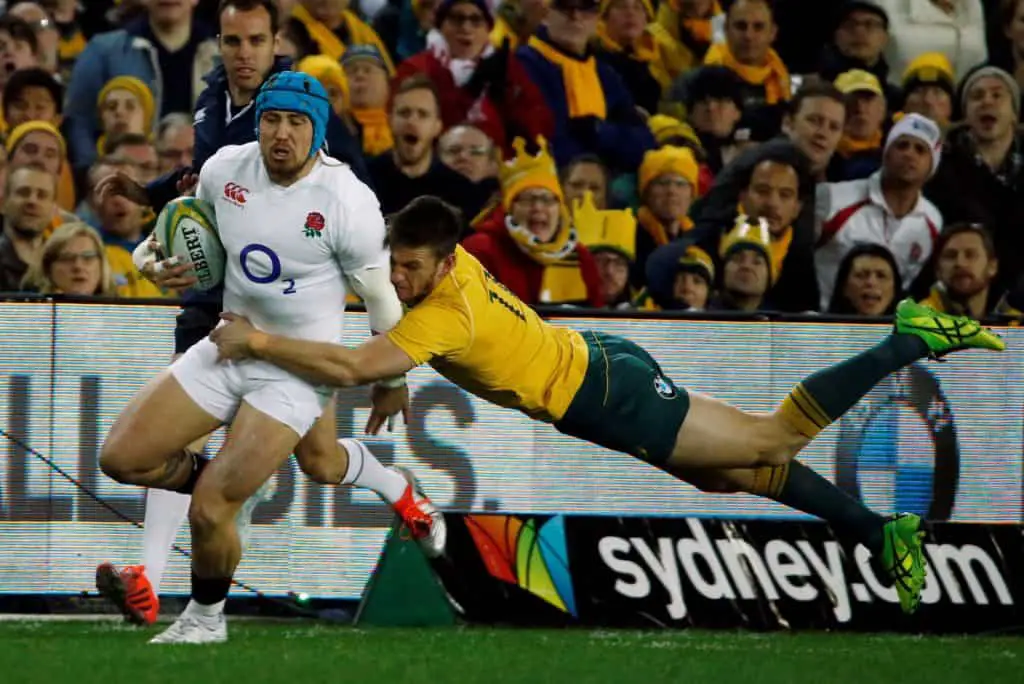
Rugby is an amazing game and tackling is a major reason why. Everyone remembers as a kid running around and tackling your friends. Well in rugby that childhood fun never stops and you can continue to run around and tackle your mates. In this article we will breakdown the purpose of tackling, how to tackle and what the do’s and don’ts are.
Can You Tackle In Rugby?
Yes, you can tackle in rugby. Rugby is a contact sport and tackling is a fundamental element of the game. Tackling is the main way in which a rugby team defends their territory and try line. There are strict rules governing tackling such as no contact above the shoulders.
Without tackling there wouldn’t be rugby. If you are looking for a sport where you can put your shoulder on and drive people to the ground then rugby is your sport as the sport will be dead before they ban tackling.
Why Do You Tackle In Rugby?

You tackle in rugby to prevent your opposition from gaining territory and eventually from crossing your try line to score. Rugby is a tactical battle over area and tackling is a method used to control and limit your opposition’s movement. Tackling can also be used to win possession for your team by forcing a knock on.
If you couldn’t tackle in rugby you would have no ability to stop your opposition from simply marching down the field and scoring. Players could attempt to establish a human great wall of China but they would run out of man power. Tackling is the major method rugby players have to stop their opposition from moving around their field with impunity.
What Is An Illegal Tackle In Rugby?

An illegal tackle in rugby is where you make contact above the shoulders, do not use your arms during the tackle, lift your opposition above horizontal and or drive their head into the ground. These rules are in place to limit concussions and spinal injuries.
A high quality legal tackle involves you lowering your level, stepping forward, getting your lead leg close to your opposition, making solid contact with your shoulder below your opposition’s shoulders and your head on the outside of his thigh, driving your opponent backwards and then wrapping your arms around your opposition’s legs as you force your him to fall to the opposite side your head is placed on.
Can You Suplex In Rugby?
No, you can not suplex in rugby. In rugby it is illegal to lift your opposition beyond horizontal. It is also illegal for your opposition to be tackled head first into the ground. If you suplex in rugby you will be penalized or given a yellow or red guard and face possible suspension from future games.
If you want to suplex you will have to take up wrestling as this move will only result in you having an early shower. The suplex and any back arching throw where you lift your opponent above horizontal is illegal.
You can use a lat drop successfully in rugby particularly when your opposition takes a quick run from a ruck and runs straight at you. If you get an underhook and combine that with your opposition’s momentum you should be able to send them tumbling to their back in a powerful dominant tackle.
Is Dump Tackling Illegal In Rugby?

Dump tackling is legal in rugby as long as you do not lift your opposition past horizontal and your opponent doesn’t make contact with his head on the ground. Dump tackling is risky as it is easy to get penalized by lifting your opponent too far.
Dump tackling is used to drive your opponent backwards which increases your team’s likelihood of winning a possession through forcing a knock on or a turnover. By picking up and driving your opposition back they will take a big fall and the ball could become dislodged. Also by driving your opponent to the ground they will have a more difficult time establishing a long place of the ball and the opposition’s forwards will be out of position making it more difficult for them to secure the ball at the breakdown.
Even though there are many benefits to dump tackling it is a high risk strategy. Referees are very strict about lifting tackles if you lift your opponent anywhere close to horizontal there is a good chance of you being penalized. This can result in you giving up a quick 3 points of handing your opposition amazing field position.
It is also difficult to execute a dump tackle. It isn’t exactly easy to drop down and pick up a top tier rugby player who is sprinting at you with his body height lowered. This is why you don’t see many dump tackles. The risk of penalty is too high and top players know how to lower their body height to avoid them.
Can You Tackle Someone Without The Ball In Rugby?
No, you can not tackle someone without the ball in rugby. This will result in a penalty and possible yellow card if your actions denied your opposition an opportunity to score. You must ensure your opponent has clear possession of the ball before you tackle them.
Can You Tackle From Behind In Rugby?

Yes, you can tackle from behind in rugby as long as the player you are tackling has the ball and you make contact below the shoulders then it is legal. Common tackling from behind methods include ankle tap and wrapping your arms around opponents body or legs and driving forward with your head placed on their body.
Tackling from behind is quite different than making a standard tackle where your opponent is moving towards you. You have to use a different style of tackling to bring an opponent who is running away from you down.
A common method to bring down a player from the behind is the ankle tap. This is often a desperation attempt to tackle your opponent. To ankle tap you need to lower your level, place your weight on your backfoot and dive at your opponent’s ankles, you may have to stretch your body as long as possible and swipe at your opponent’s ankles with your hand. The ankle tap is all about timing if you get it right you look like a genius, if you don’t you end up eating turf.
Another common method to tackling from behind is a standard rugby tackle but with a few modifications. When tackling from behind you will often have to make contact with your arms before your shoulders to prevent your opposition from running further away from you. Once you have made contact with your arms you then can use your shoulder to add power to your tackle. You also have to incorporate a dive into your tackle if you are having trouble closing the distance between you and your nippy opposition.
When tackling from you will to tackle straight on as opposed to many rugby tackles where you tackle at an angle. When tackling someone from behind you need to keep your head glued to the centre of your opposition and not on the side. If you keep your head on the side you will end up landing head first into ground. Instead place your head on your opposition’s body and use their body to cushion your fall.
Can You Tackle Someone In The Air In Rugby
No you can not tackle someone in the air in rugby. If your opposition has both feet off the ground you can not tackle him. This will result in a penalty. Tackling in the air is illegal because it can result in nasty falls leading to concussions and spinal injuries.
Rugby players will often take advantage of this rule by launching themselves high up into the air to take a kick, preventing their opposition from tackling them. This is a common tactic in modern rugby.
You can tackle someone as soon as they place one foot on the ground. You will often see in rugby that players will time their chase of a kick so they arrive just as their opposition is returning from the ground after catching the kick so they can unleash a dominant tackle. Driving their opposition back in hopes of forcing a turnover at the breakdown.
Conclusion
Tackling is a major component of rugby as it is used to prevent your opposition from moving freely around the pitch. As tackling is potentially dangerous there are strict rules dictating what you can’t do including no contact above the shoulders, no shoulder charging and no lifting past horizontal. If you love the idea of tackling someone to the ground then you need to give rugby a go as it will give you all the tackling you can handle.
